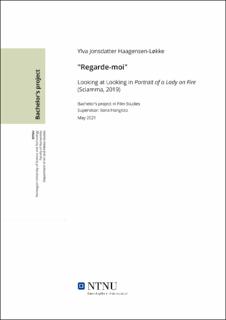| dc.contributor.advisor | Hongisto, Ilona | |
| dc.contributor.author | Haagensen-Løkke, Ylva Jonsdatter | |
| dc.date.accessioned | 2021-09-14T16:13:20Z | |
| dc.date.available | 2021-09-14T16:13:20Z | |
| dc.date.issued | 2021 | |
| dc.identifier | no.ntnu:inspera:76749986:34431113 | |
| dc.identifier.uri | https://hdl.handle.net/11250/2776627 | |
| dc.description.abstract | Denne bacheloroppgaven undersøker om filmen Portrait of a Lady on Fire (Sciamma, 2019) utfordrer tradisjonelle betraktningsmåter i film. Oppgaven ser også på om filmen representerer et alternativ til Laura Mulveys teori om det mannlige blikk (male gaze theory) og tradisjonell Hollywoodfilms bruk av blikk. Oppgaven bruker en tilpasset diskursanalyse som analyserer filmen ut ifra fire ulike betraktningsmåter. Analyseverktøyet som er utviklet er basert på Foucaults «grille»-konsept og deler analysen inn i fire ulike argumenter som sammen gir innsikt i hvorvidt Portrait of a Lady on Fire utfordrer Mulveys teori om det mannlige blikk. Oppgaven plasserer også filmen innenfor lesbisk filmhistorie. Resultatene viser at Portrait of a Lady on Fire bruker blikk som et grunnleggende verktøy for å etablere maktdynamikken mellom filmens karakterer og seeren på en måte som står i kontrast til tradisjonell Hollywood-film og det mannlige blikket. Det er imidlertid umulig å fastslå hvorvidt bruken av blikk i Portrait of a Lady on Fire er del av en ny og større diskursendring innen lesbisk film. | |
| dc.description.abstract | The purpose of this paper is to investigate the 2019 film Portrait of a Lady on Fire (Sciamma) and to determine whether it challenges the traditional ways of looking in film. My aim is to investigate whether the film represents an alternative to Laura Mulvey’s male gaze theory and classic Hollywood’s use of looking. The method section in the essay is inspired by discourse analysis adapted to analyse four different dimensions or levels of looking using Foucault’s concept of the “grille”. The analysis is thus divided into to four distinct arguments to investigate whether the film challenges Mulvey's gaze theory. In addition, the essay places the film within the history of lesbian cinema. The results indicate that Portrait of a Lady on Fire uses looking as a fundamental tool for establishing the power dynamic between its main characters and the audience in a way that is seemingly in contradiction with the male gaze and traditional ways of looking in classic Hollywood narratives. However, it is impossible to confidently determine whether looking in Portrait of a Lady on Fire is part of a new and larger discourse change within lesbian cinema. | |
| dc.language | eng | |
| dc.publisher | NTNU | |
| dc.title | "Regarde-moi": Looking at Looking in Portrait of a Lady on Fire (Sciamma, 2019) | |
| dc.type | Bachelor thesis | |
